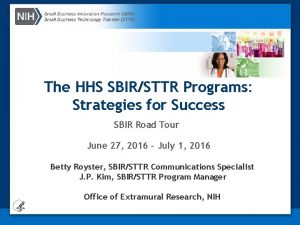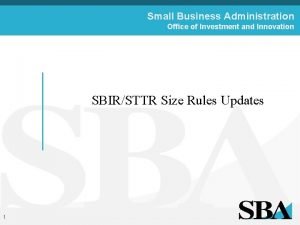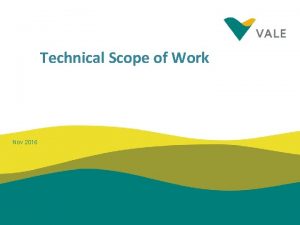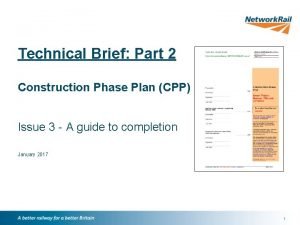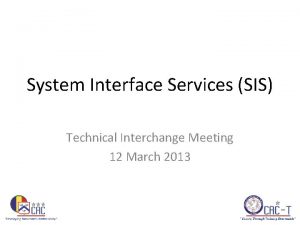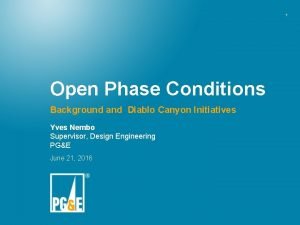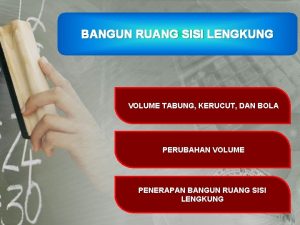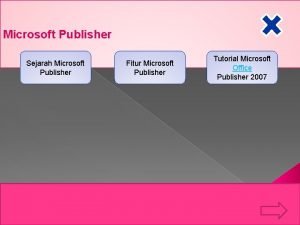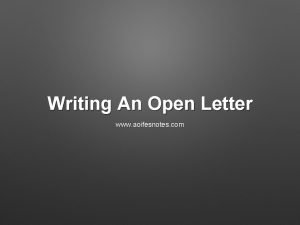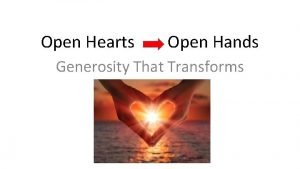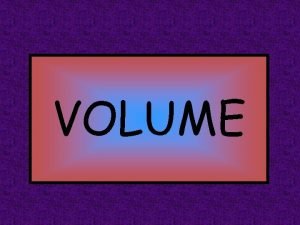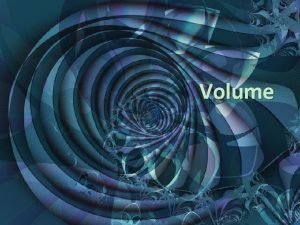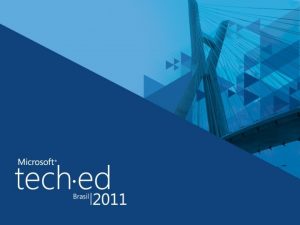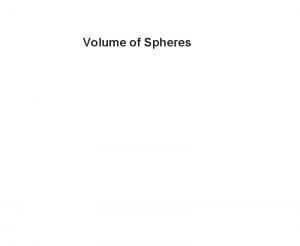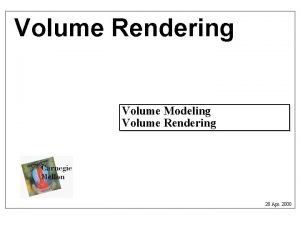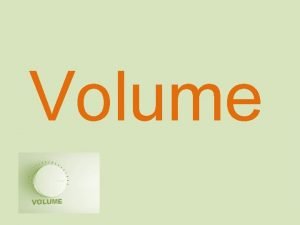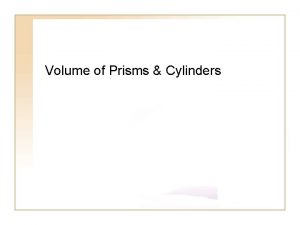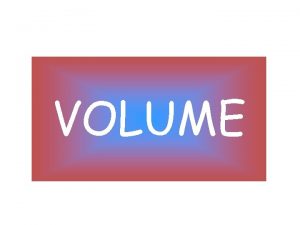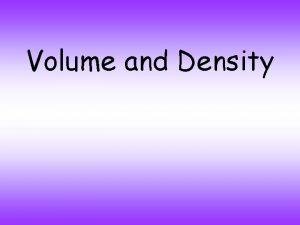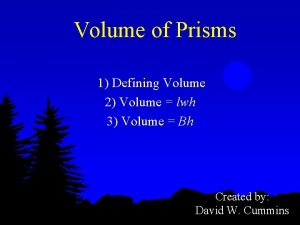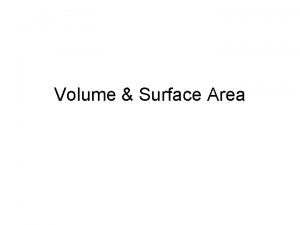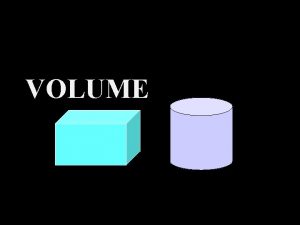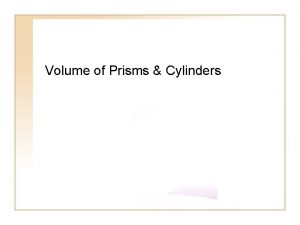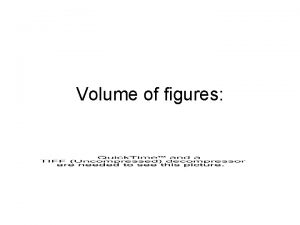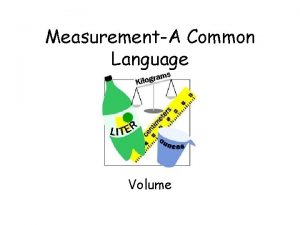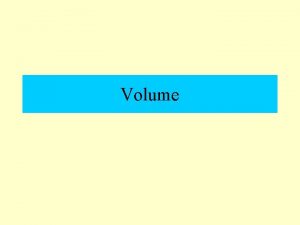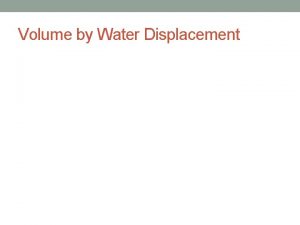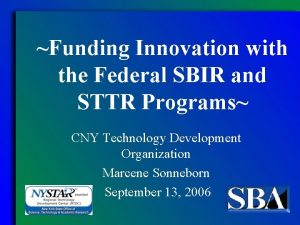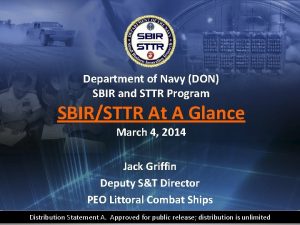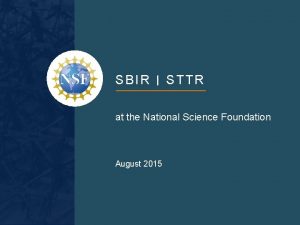STTR Open Topic Phase I Technical Volume Template



























- Slides: 27

STTR Open Topic Phase I Technical Volume Template (Applicable to X 21. B) Sample - For reference only Please send questions to usaf. team@afsbirsttr. us Notional example - For reference only 1

Photo: A solution picture/ screenshot verifies proposal isn’t for ‘vaporware’. Overall Summary Slide • • Include Company Name and Overview of Proposal • Team: One sentence could describe the proposed team's ability to perform the task and commercialize the results. • Technical Abstract: This is the first thing reviewers see so make it very clear. Overview: One sentence could include a quick overview of the Phase I objectives. Technical Merit: One sentence could clearly describe the effort’s technical merit, including the solution’s risk mitigation in the commercial marketplace. Commercialization: One sentence could focus on the solution’s intended commercialization. If the slide deck contains proprietary information, include this statement VERBATIM on the first slide. "This proposal includes data that shall not be disclosed outside the Government and shall not be duplicated, used, or disclosed-in whole or in part-for any purpose other than to evaluate this proposal. If, however, a contract is awarded to this offeror as a result of – or in connection with – the submission of this data, the Government shall have the right to duplicate, use, or disclose the data to the extent provided in the resulting contract. This restriction does not limit the Government's right to use information contained in this data if it is obtained from another source without restriction. The data subject to this restriction are contained in pages [insert numbers or other identification of sheets]" Notional example - For reference only 2

Technical Merit Summary • • Include the most effective points demonstrating the solutions technical merit and remaining technological risk Show, don’t tell - use evidence to demonstrate the solution does not carry significant technical risk These lists are not exhaustive - use your own ideas to best demonstrate (not tell) why your solution has technical merit If adapting the firm’s own non-defense solution: • • • Pictures/screenshots of the solution in use Pictures/screenshots of the solution Sales numbers for similar/related non-defense commercial solutions Customer interview testimonials/quotes Investment from entities experienced in evaluating technological merit If the solution is based on another entity’s commercially available technologies: • • • Pictures of the technology’s actual implementation combined into the proposed solution Pictures of end users/customers testing the combined implementation Investment from investors experienced in evaluating technological merit For every slide with proprietary information, include this statement in the footer. "Use or disclosure of data contained on this page is subject to the restriction on the first page of this volume. " Notional example - For reference only 3

Significance of Problem/Opportunity • Define the specific technical problem/opportunity addressed and its importance. Include a brief proposed solution description and WHY IT IS SUPERIOR TO CURRENT ALTERNATIVES, as applied to both Defense and non-Defense customers. • This is not intended to expound on technical depth, but rather to explain the technology/value proposition and its importance. “You do not really understand something until you can explain it to your grandmother. " Notional example - For reference only 4

Summary of Commercialization Potential Not all VCs/investors are created equal. It is not just about money, it is also about the commercialization track record • Communicate the most effective points demonstrating the firm’s ability to commercialize the solution within Do. D AND the commercial sector. • For non-Defense commercialization • • Target non-Defense version of the solution’s customer and market • Solution (or similar) trials with non-Defense customers • • • Outside investment from entities with proven technology commercialization records, e. g. , venture capitalists, accredited investors • Quotes/specifics from trial customers There is a high risk of ‘vaporware’ with this topic. Offerors must be specific about the actual solution and demonstrate a path to existence Broad, general statements regarding potential market size are not heavily valued For Defense commercialization • Discuss stakeholders needed to transition the solution to a Program of Record, e. g. , contracting, finance, legal, security, information assurance, etc. • Major Defense contractors are helpful but do not replace AF users/stakeholders If there are no dollar signs on this slide, there is something missing. Firms COMPETITIVE LANDSCAPE: What is the solution’s competition? Are other should demonstrate entities working on this solution? How is the proposed solution superior to the knowledge of the completion? customer/market(s) Notional example - For reference only 5

Summary of Commercial Potential (cont’d) • • • Explain the anticipated Air Force customer, i. e. , acquisition professional; it is unlikely this person will be the Air Force end-user, i. e. , operator. To achieve success, the firm must understand the user and customer. Discuss Government organizations/individuals the firm intends to contact to initiate the customer discovery process • • ‘The Air Force’ is not a valid answer • • • Discuss lessons learned from Do. D user testing or customer discovery Name specific units or people with whom the firm’s customer discovery will begin Obtain feedback from actual users, not just scientists and engineers Major Defense contractors are helpful but DO NOT replace AF users/ stakeholders Plans for non-Defense commercialization • • Sales numbers for the solution’s non-Defense commercial version(s) Investment from entities experienced in commercializing Notional example - For reference only 6

Summary of Team’s Ability to Perform Research and Commercialize the Solution • Discuss the team’s most effective points for demonstrating continued technical development AND commercialization for Air Force customers • The ability to execute a successful STTR effort and commercialize within the Government is largely based on people, as they enable product/ market fit determination The question is not only can the firm do it, but can it be done within compressed timelines? H 4 D is a good resources for Do. D customer discovery: http: //hacking 4 defens e. stanford. edu/ Like in the non-Defense sector, firms must be entrepreneurial to succeed in the sales cycle Notional example - For reference only 7

Defense Need • • • Discuss prospective AF end-user(s)/customer(s) and the solution’s most reasonable related use-case Highlight previous Do. D funding for the solution or underlying technology, e. g. , AFOSR research grants, etc. Talk about the proposed solution as it compares to the user’s current alternative Government commercialization potential was addressed previously; this section details the solution’s user- and organizational-level need. If applicable, reference a Strategic Capability area as described in the X 21. B STTR CSO Section 2. 1. • Why is the solution important to users and better than the current alternative? • Why is it important to the DAF? How does it tie into known needs and/or priorities? • What direct user- or organizational-level benefits are expected following the solution’s implementation? Notional example - For reference only 8

Phase I Objectives • Enumerate specific Phase I objectives, including answers needed to determine the proposed approach and proof-of-concept development feasibility. Describe the problem/benefit area related to the solution. Discuss the solution’s success in terms of measurements in meeting the user’s need(s). • List at least one Air Force working-level organization or community which could benefit from the solution. This is VERY important - who is the first AF Stakeholder you will contact once you start your Phase I? If you have trouble with this, try looking through news reports or networking websites. Notional example - For reference only 9

Do NOT include proprietary information on this slide Work Plan / Statement of Work (SOW) • Provide an explicit, detailed Phase I approach description. The work plan should include planned tasks, how/where work will be conducted, a major events schedule, and associated deliverables. Deliverables should include the following: 1) preliminary report, including a one-slide project summary; 2) final report, providing explicit, detailed discussion of methods to achieve each objective/task. Describe specific tasks, duration, description, and performers to complete each. Include subcontractors’ efforts as well. Example: Task Duration Description Performer 01 – Write Preliminary Report (DELIVERABLE) Days 0 -5 We will write the initial 15 -slide report describing our research approach to accomplish this Phase I feasibility study. Jane Doe 02 – USAF Customer Discovery Days 0 -60 We will begin by reaching out to SSgt Snuffy, and will attend several conferences related to Aircraft maintenance. We will also attend the AF Collider event. Jane Doe, Bob Smith 03 – Problem Refinement Days 15 -60 We will perform site visits with our most promising USAF End-Users in order to deeply understand their problem Bob Smith, Abe Lincoln 04 – Technical Adaptation/Modification Study Days 40 -80 Our engineers will work to define the necessary adaptations of our nondefense commercial solution to meet the needs of our final AF End-User. Abe Lincoln, Vanenvar Bush 05 – Definition of Solution Trial with AF End. User and AF Customer Days 40 -90 We will work with our AF End-User (Operator) and the associated AF Customer (Acquisitions expert) to clearly define a set of milestones and a trial to demonstrate how our adapted solution can meet the needs of the specific Air Force end-user. Vanevar Bush, Jane Doe 06 – Write Final Report (DELIVERABLE) Days 60 -90 We will incorporate all of the information derived from tasks 02 -05 to write the final report that is 15 pages, 15 slides and a 100 second video. Jane Doe Notional example - For reference only 10

Transition Plan • • Describe the solution’s Air Force transition plan. *Briefly* discuss the proposed solution’s integration with the proposed Air Force customer’s existing technology • What integration efforts must be completed before the solution is ‘useable’ by the intended Air Force customers? • What regulatory, policy, or other compliance efforts must be undertaken for the solution implementation? Who must be part of the transition plan? Who must be ‘on-board’ when scaling past the solution’s early adopters? Functional or command leadership? Regulatory bodies? • A list of high-level Air Force ‘Customers’, i. e. , Program Executive Offices, can be found here: https: //www. dropbox. com/s/e 00 ljab 5 qdjdb 9 d/AF%20 Acquisitions%20 %28 PEOs%29%20 Cheat%20 Sheet. pdf? dl=0 Notional example - For reference only 11

Related Work (Dual-Use) • • Describe significant activities directly related to the proposed effort, including the principal investigator, proposing firm, consultants, or others. Describe how these activities interface with the proposed project. Discuss planned coordination with outside sources. The technical volume must convince reviewers the proposer is aware of the specific topic’s state-of-the-art. Describe relevant previous/parallel work not directly related to the proposed effort. Provide (1) a short description, (2) related client, including POC name/phone number, and (3) date completed. Describe non-Defense customers, including interviews conducted, if any. Describe Defense customers, including interviews conducted, if any. Discuss the solution’s competitive landscape. There is focus on attaching Defense solutions to technological change’s pace, requiring non-Defense/non-Government commercial solutions. Notional example - For reference only For STTR Phase I, include information regarding user interviews accomplished. 12

Clearances / Certifications / Approvals / Registrations • Include the System for Award (sam. gov) Dun and Bradstreet number (DUNS), Commercial and Government Entity (CAGE) code, and Small Business Administration (SBA) ID. A valid CAGE code is required to receive consideration for award. Lack of a valid CAGE code at proposal submission will result in disqualification. • DUNS Number: ______ If the firm does not have a DUNS number, register here: https: //fedgov. dnb. com/webform • System for Award Management (SAM) • • CAGE Code: _____ If the firm is not registered in SAM and obtained a CAGE code, register here: https: //www. sam. gov/portal/SAM/) Small Business Association ID • SBA SBC ID Number: _____ If the firm is not registered with the SBA and obtained the ‘Small Business Concern’ (SBC) Identification (ID) number, register here: https: //www. sbir. gov/registration) Notional example - For reference only 13

‘As-Applicable’ Slides Notional example - For reference only

Key Personnel (Continuation of ‘Team’s Ability to Perform Research’ slide) • Identify key personnel involved in the effort including directly related education and experience. Provide a concise technical resume of the principal investigator, including a list of relevant publications (if any). Describe how team members’ backgrounds qualify them for the specific work to be performed on this project. Full resumes for key technical personnel should be included in Volume 5: Supporting Information. • This section should include brief descriptions of the qualifications of your key personnel. Include details that are relevant to their role on the team for this Phase I research. Include any military experience as it pertains for their ability to better understand the needs of a potential Air Force stakeholder. Key personnel should include: • Principal Investigator (required) • Research Institute POC (required) • Key Technical Personnel (required • Relevant Advisors • Relevant Investors • Key consultants • Key members of any sub-contractors • Any other key members of the team. What percentage of the principal investigator's total time will be on the project? • i. Any non-zero answer is awardable. • ii. If the answer is below 25%, please describe the principal investigator’s other roles. • • • NOTIONAL EXAMPLE: Our principal investigator intends to spend 20% of her time (~8 hours per week) working on this Phase I. Her other responsibilities include spending 30% of her time managing our nondefense commercial clients and she is spending 50% of her time on a prior Phase II that was awarded with the Air Force in March of 2019 (contract No. FA 123456 CA 789). Notional example - For reference only 15

Commercialization Strategy (Continuation of ‘Commercialization’ slide) • Describe in >one page the company's strategy for technology commercialization in Do. D, other Federal agency, AND private sector markets. Provide specific information regarding the solution’s answer to a market need and related market size. Include a quantitative commercialization result schedule the company expects to achieve. Describe outside investment, cash flow sources, and potential to scale. Focus mainly on non-Defense sales. • PREVIOUS OUTSIDE INVESTMENT: Has the firm received outside investment? How much and who are the investors? Was this investment to further solution-related technology development? • SOURCES OF CASH FLOW: How will this particular solution generate firm cash flow? Is funding being realized from investors? Are there non-Defense sales or leads? Defense sales? Government grants and/or contracts? Independent research and development (IRAD) funding? What are the potential Defense sales sources? • POTENTIAL TO SCALE: How far can the firm and solution scale to capture a large market? Provide examples of team members with demonstrated ability to scale solutions and/or companies. Notional example - For reference only 16

Relationship with Future Work (Potential extension of ‘Commercialization’ slide) • (a) State the anticipated results if the project is successful. (b) Discuss Phase I significance in creating a foundation for Phase II. (c) Identify required clearances, certifications, and approvals to conduct Phase II testing. Discuss the plan to ensure timely authorizations’ completion. Identify high-level Air Force customer, e. g. , Air Force Research Laboratory, and integration of the solution with their current state. • PROPOSED HIGH-LEVEL AIR FORCE CUSTOMER: Chooee Program(s) of Record, then state the solution’s potential integration with the current state(s). Propose areas with greatest potential for integrating the solution into the Air Force (For additional information, search on “Air Force”_______) PEO Fighter/Bomber PEO Business and Enterprise Systems PEO Armament PEO Presidential and Executive Airlift PEO Tanker PEO Mobility and Training Aircraft PEO Agile Combat Support PEO Digital PEO Command, Control, Communication, Intelligence, and Networks PEO Intelligence, Surveillance, Reconnaissance and Special Operations Forces PEO Services (Combat and Mission Support) PEO Space Systems (Space Force) PEO Strategic Systems PEO Nuclear Command, Control and Communications F-35 Program Office Rapid Capabilities Office Rapid Sustainment Office Air Force Research Laboratory’s Technical Directorate, i. e. , Aerospace Systems (RQ); Sensors (RY), Materials and Manufacturing (RX); 711 Human Performance Wing/Human Effectiveness (RH)/USAFSAM; Munitions (RW); Information & Cyber (RI); Space Vehicles (RV); Directed Energy); Air Force Office of Scientific Research (AFOSR) Other • SOLUTION’S INTEGRATION DESCRIPTION: After researching the Air Force customer, briefly describe the proposed solution’s integration with the customer's current state. Sample: The software solution automatically completes lines of code while typing and double checks for errors, instituting a testing level during the software writing. PEO Digital seeks methods for speeding development to the warfighter, currently developing solutions to better organize and task forces. The proposed solution could ensure a lower error rate for fielded systems, thus increasing speed. Notional example - For reference only 17

Firm Ownership (Remove questions which don’t apply. ) • Question 5) Is 50% or more of your firm owned or managed by a corporate entity? • i. If YES, and the corporate entity is also a small business as described in section 3. 15, please include in this section a description of your corporate relationship, including any other affiliates of the owning corporate entity. • ii. If your firm is 50% or more owned or managed by a corporate entity that is not a small business, your proposal will be disqualified. • NOTIONAL EXAMPLE: My firm, ‘Small SSA LLC’ was ‘spun-out’ of another small business, ‘Small Rocket Co. ’, to focus on the emerging space situation awareness market. Small Rocket Co. owns a 75% stake in ‘Small SSA LLC’. Small Rocket Co. is also classified as a small business concern via the SBA and has no other affiliates. The total size of all of the affiliates is still less than 500 employees, with Small Rocket Co having 147 employees and ‘Small SSA LLC’ having just 13, making our total number of employees, including affiliates equal to 160. • Question 11) Is your firm registered in the SBA's venture capital database as majority-owned by venture capital operating companies, hedge funds, or private equity firms? • i. If YES, please state whether the VCOC, hedge fund, or private equity firm is also a small business as defined by the SBA. If so, then the VCOC, hedge fund, or private equity firm would count as an ‘affiliate’ and their employee numbers will need to be added to your employee total. • ii. If your firm is majority-owned by venture capital operating companies, hedge funds, or private equity firms that do NOT qualify as a small business concerns, your proposal will be disqualified from the Air Force Special Topic. • Question 12) Is your firm more than 50% owned by a single Venture Capital Owned Company (VCOC), hedge fund, or private equity firm? • i. If YES, please state whether the VCOC, hedge fund, or private equity firm is also a small business as defined by the SBA. If so, then the VCOC, hedge fund, or private equity firm would count as an ‘affiliate’ and their employee numbers will need to be added to your employee total. • ii. If your firm is more than 50% owned by a single venture capital operating company, hedge fund, or private equity firm that does NOT qualify as a small business concern, your proposal will be disqualified. • Question 13) Is your firm more than 50% owned by multiple business concerns that are VCOCs, hedge funds, or private equity firms? • i. If YES, please state whether the VCOC, hedge fund, or private equity firm is also a small business as defined by the SBA. If so, then the VCOC, hedge fund, or private equity firm would count as an ‘affiliate’ and their employee numbers will need to be added to your employee total. • ii. If your firm is more than 50% owned by multiple venture capital operating companies, hedge funds, or private equity firms that do NOT qualify as a small business concerns, your proposal will be disqualified. • If the answer to questions 10, 11, or 12 is ‘YES, explain the firm’s ownership structure. If the venture capital operating company (VCOC), hedge fund, or private investment firm with equity in the company is itself small business, the company is likely eligible for award. Companies majority owned (<51%) owned by multiple VCOCs, hedge funds, or private investment firms are ineligible for award under the X 21. B STTR CSO. • Question 15) Is your firm affiliated as set forth in 13 CFR 121. 103? • i. If yes, then please describe your affiliations as described here: https: // www. sba. gov/document/support--affiliation-guide-size-standards • • NOTIONAL EXAMPLE: “Carbon Fiber Wheels LLC is an affiliate of ‘High End Cars Corp. ’; the boards of directors share 3 of 5 members. ” 23) Are teaming partners or subcontractors proposed? • i. If yes, be sure to include this information in the proposal Coversheet, Cost Volume and Supplemental Cost Information. • For this question – be sure to include your sub-contractor information in the Cost Volume (how much you are subcontracting them for) and in the Supplemental Cost Information by including the agreements between your firm and the subcontractor. If you are teaming with another firm, but not sub-contracting them, be sure to include this teaming arrangement in Volume 5: Supplemental Information. Notional example - For reference only 18

Foreign Citizens • • Identify foreign or dual citizens expected to be involved on this project as direct employees. For these individuals, please specify countries of origin, the visa or work permit type held, and their anticipated assigned tasks. Do not assume the individuals possess the required documentation to participate in the effort. Firms shall report all “foreign nationals” as defined in Section 3. 5 of the X 21. B STTR CSO intended to perform, if selected for award. Offerors may be asked to provide additional information during negotiations to verify foreign citizens’ eligibility. All information provided to determine eligibility will be protected in accordance with the Privacy Act, 5 USC 552 a, if applicable, and Freedom of Information Act, 5 USC 552(b)(6). An H-1 B visa allows non-US citizen graduate students in specialty areas to be employed for efforts directly pertaining to their graduate studies. More information: https: //workpermit. com/immigration/usa/us-h-1 b-visa-occupation-list. H-1 B visa holders cannot work <20 hours/week on a single project. Full Name Foreign National (Yes or No) Country of Origin Type of Visa or Work Permit Description of Involvement (specific task(s) in the work plan) Nikola Tesla Yes Serbia Work Visa - (E 2): Professionals Holding Advanced Degrees and Persons of Exceptional Ability) Task 04 – Technical Modification Study Notional example - For reference only 19

Facilities/Equipment • Describe facilities or equipment/instrumentation proposed for use during Phase I. Verify the location where the proposed work will be accomplished meets federal, state, and local Governments environmental laws and regulations for, but not limited to, airborne emissions; waterborne effluents; external radiation levels; outdoor noise; solid and bulk waste disposal practices; and toxic/hazardous materials storage/disposal. • Confirm the following statement is true and include verbatim on this slide: “All of the facilities where the proposed work will be performed meet Federal, state, and local governments’ environmental laws and regulations. ” Notional example - For reference only 20

Prior, Current, or Pending Support of Similar Proposals or Awards • If a proposal submitted under this solicitation is substantially the same as another proposal previously or currently funded or pending funding with another Air Force organization, Do. D component, or other Federal agency, the offeror must state so on the Proposal Cover Sheet, providing this information: (a) Name/address of the Air Force organization, Do. D component, or Federal Agency(s) to which an essentially equivalent proposal was submitted, will be submitted, or from which an award is expected or has been received. (b) Proposal submission or award date. (c) Proposal Title. (d) Principal Investigator’s name/title for each proposal submitted or award received. (e) Solicitation and topic titles/numbers/dates under which proposals were submitted, will be submitted, or under which award is expected or has been received. (f) If award was received, state contract number. Note: If this does not apply, state "No prior, current, or pending support for proposed work. “ • • Question 18) Has a proposal for essentially equivalent work been submitted to other US government agencies or DOD components? If the answer to this question is yes, you must include the requested information in the Coversheet Supplement. This is very important for the open topic wherein many companies adapt solutions for different customers/requirements. However, accepting awards for essentially equivalent work constitutes fraud. If proposals have been submitted to ANY other AF, Do. D component, or Federal agency’s solicitation/topic, reflect in the table below. Failure to disclose may disqualify the immediate proposal. Name of Federal Agency Date of Proposal to which the Proposal Submission was submitted Title of Proposal and (if Name of Principal SBIR/STTR) Proposal Number Investigator Was awarded? If so, include contract number. Air Force AF 192 -001 -0123 ‘Edge Neural Net Processor - Phase I’ YES – FA 123456 CA 789 28 June 2019 Dr. William Shockley Notional example - For reference only 21

Technical Data Rights (Assertions) • If the firm intends to deliver specific non-commercial technical data or non-commercial software developed at private expense to the Government it shall submit that information using the table below. This is not typical in Phase I but frequent in Phases II and III. The SBIR/STTR data rights clause will be incorporated into the purchase order and is intended to protect the firm’s interests as the solution’s development progresses. • Rights in technical data, including software, developed under the terms of any contract resulting from proposals submitted in response to this CSO generally remain with the contractor. The Government obtains a royalty-free license to use the technical data for Government purposes commencing with contract award and ending five years after project completion. This data should be marked with the restrictive legend specified in DFARS 252. 227 -7018. Upon expiration of the five-year restrictive license, the Government has unlimited rights in the STTR data. During the license period, the Government may not release or disclose STTR data to any person other than its support services contractors except (1) for evaluation purposes; (2) as expressly permitted by the contractor; or (3) for use, release, or disclosure necessary for emergency repair or overhaul of items operated by the Government. See DFARS clause 252. 227 -7018, "Rights in Noncommercial Technical Data and Computer Software – Small Business Innovation Research (SBIR) Program. " • Data rights asserted IAW DFARS 252. 227 -7018 must be identified, assertion of use, release, or disclosure restriction captured in the table below, and included in the proposal. The contract cannot be awarded until assertions have been approved by the Government Program Manager, Air Force Legal Counsel, and others as appropriate. Technical Data or Computer Software to be Furnished With Restrictions (LIST) Basis for Assertion None Developed exclusively at private expense Developed partially at private expense (LIST) Asserted Rights Category None Government Purpose Limited (Technical Data) Restricted (Software) Specifically Negotiated License SBIR/STTR (LIST) Notional example - For reference only Name of Person Asserting Restrictions (LIST) 22

Supplemental Information on Direct Labor Costs This table is needed only if estimated hourly rates are very high. • For any notable instances e. g. , a significant number of hours, very high hourly wages, or significant labor overhead/fringe rates, justify in this section. Wage rate information is available at https: //www. bls. gov/blswage. htm. • All estimated costs are meant to be estimates used to determine the proposed effort’s price reasonableness. Phase I awards are issued as firm fixed price purchase orders. Employee Name Position Location Grace Hopper Software Developer San Francisco Proposed Rate/Hour $250 BLS Average Rate/Hour Rationale $69. 25 Grace is a skilled programmer with degrees from Vassar and Yale. She is one of the original developers of a critical software language (COBOL). Additionally the market demand for software developers is very high in San Francisco right now. Notional example - For reference only 23

Supplemental Information for Direct Material Costs • Justify materials, parts, and supplies costs with an itemized list of types, quantities, price and, where appropriate, purpose. For the materials, please provide the listed costs’ bases, e. g. , historical information, vendor quotes, catalogs, etc. • Typically, there will not be a significant amount of direct material costs Phase I feasibility study. Offerors may need this information to discuss solutions during interactions with potential AF end-users/customers. If significant direct materials will be needed, list here. Description 3 D Printing Filament Quantity 40 Spools Price Purpose Basis for cost $28. 11/spool In order to adapt the sensor mount https: //www. mcmaster. to the F-16, 100 different variations com/1317 n 13 will be printed to obtain user feedback regarding the best. Notional example - For reference only 24

Detailed Travel Costs (Included in Other Direct Costs) • If travel is proposed as an Other Direct Cost, provide supporting information here. Travel costs must be justified and related to the proposed effort. Provide the number of trips, travelers per trip, specific locations, and purpose of each. Include, to the extent practicable, the basis for proposed flights, lodging, per diem (meals), and ground transportation costs. More information is available at https: //www. gsa. gov/travel/plan-book/per-diem-rates. • These costs are estimates; it is likely travel costs incurred will be different. The proposal information allows Government Contracting Officers to determined the proposed costs reasonable. Trip Attendees Estimated Airfare Attend Spark Collider (Boston, MA - Austin, TX) 1. Ada Lovelace 2. Albert Einstein Estimated Lodging $600 $250/night 3 Nights ($750 Total) Estimated Meals & Incidentals $145/day 4 days ($580 Total) Notional example - For reference only Total Cost $3, 860 25

Supplemental Information for Special Tooling/Test Equipment • • While special tooling/test equipment and material cost can be proposed for Phase I, it will be carefully reviewed in relation to and necessity of work proposed. The Government Contracting Officer must determine special tooling/test equipment purchases as advantageous to the Government and directly related to the proposed effort. This includes items such as innovative instrumentation or automatic test equipment. Title to Government furnished property or that acquired with Government funds will be vested with the Air Force, unless it is determined title transfer to the contractor is more cost effective than recovery. Most companies will not require specialized equipment for the Phase I feasibility study. This equipment would be purchased strictly to perform the Phase I effort. If it is intended for other uses, such as for non-Defense applications, it is NOT appropriate to include it in the proposal. Specialized equipment purchased specifically for the Phase I effort may require transfer to the Government after Phase I performance, if cost effective to do so. Phase I specialized equipment costs, if any, should be included using the table below. Equipment Purpose Drop Test Machine (small electronics, 2 M height) Our Air Force end-users require higher drop protection for our high security smart phone than our commercial customers, therefore we will need to purchase a drop testing equipment to make sure it meets their needs. Cost Notional example - For reference only Basis for Cost $9, 845 www. droptestmachine. com/ smallelectronic 2 M 26

References / Acronyms • List references or acronyms used in the proposal here, if any. Notional example - For reference only 27
 Hhs sbir sttr
Hhs sbir sttr Sbir sttr company registry
Sbir sttr company registry 영국 beis
영국 beis General topic example
General topic example Narrowed down topic
Narrowed down topic Normal phase vs reverse phase chromatography
Normal phase vs reverse phase chromatography Hplc reverse phase vs normal phase
Hplc reverse phase vs normal phase Mobile phase and stationary phase
Mobile phase and stationary phase Chromatography means
Chromatography means Normal phase vs reverse phase chromatography
Normal phase vs reverse phase chromatography Phase to phase voltage
Phase to phase voltage Hplc detector types
Hplc detector types In a triangle connected source feeding a y connected load
In a triangle connected source feeding a y connected load Broad phase vs narrow phase
Broad phase vs narrow phase Technical scope
Technical scope Construction phase plan template
Construction phase plan template Technical interchange meeting template
Technical interchange meeting template Diablo 1 phasing
Diablo 1 phasing Pressure-volume loop
Pressure-volume loop Stroke volume
Stroke volume Volume of solute divided by volume of solution * 100
Volume of solute divided by volume of solution * 100 Closing volume vs residual volume
Closing volume vs residual volume Volume tabung kerucut
Volume tabung kerucut Large volume parenterals means
Large volume parenterals means Microsoft publisher 1991
Microsoft publisher 1991 Aoifenotes
Aoifenotes Normally closed timed closed contact symbol
Normally closed timed closed contact symbol Open hearts open hands
Open hearts open hands
